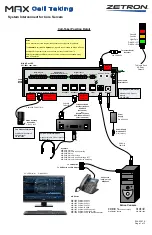
3
1–1 General
Tempco’s TEC-x100 Series Fuzzy Logic plus PID
microprocessor-based controllers incorporate two bright easy to
read 4-digit LED displays, indicating process value and set point
value. The process value (PV) display is always the top digital
display. The setpoint (SV) display is always the bottom display.
Fuzzy Logic technology enables a process to reach a
predetermined set point in the shortest time with a minimum of
overshoot during power-up or external load disturbance.
TEC-9100 is a 1/16 DIN size panel mount controller. TEC-7100
is a 72
×
72 DIN size panel mount controller. TEC-8100 is a 1/8
DIN size panel mount controller and TEC-4100 is a 1/4 DIN size
panel mount controller. These units are powered by 11–26 or 90–
250 VDC/VAC 50/60 Hz supply, incorporating a 2 amp control
relay output as standard. The second output can be used as a
cooling control or an alarm. Both outputs can select triac, 5V
logic output, linear current, or linear voltage to drive an external
device. There are six types of alarm plus a dwell timer that can
be configured for the third output. The units are fully
programmable for PT100 RTD and thermocouple types J, K, T,
E, B, R, S, N, and L with no need to modify the unit. The input
signal is digitized by using an 18-bit A to D converter. Its fast
sampling rate allows the unit to control fast processes.
Digital communications RS-485 or RS-232 (excluding TEC-
7100) are available as an additional option. These options allow
the units to be integrated with supervisory control systems and
software.
A programming port is available for automatic configuration,
calibration, and testing without the need to access the keys on the
front panel.
By using proprietary Fuzzy modified PID technology, the control
loop will minimize overshoot and undershoot in a short time. The
following diagram is a comparison of results with and without
Fuzzy technology.
High accuracy
This series is manufactured with custom
designed ASIC (Application Specific
Integrated Circuit) technology which
contains an 18-bit A to D converter for
high resolution measurement (true 0.1°F
resolution for thermocouple and PT100)
and a 15-bit D to A converter for linear
current or voltage control output. The
ASIC technology provides improved
operating performance, low cost,
enhanced reliability and higher density.
Fast sampling rate
The sampling rate of the input A to D
converter is 5 times/second. The fast
sampling rate allows this series to control
fast processes.
Fuzzy control
The function of Fuzzy control is to adjust
PID parameters from time to time in order
to make manipulation of the output value
more flexible and adaptive to various
processes. The result is to enable a process
to reach a predetermined set point in the
shortest time, with the minimum of
overshoot and undershoot during power-
up or external load disturbance.
Digital communication
The units are equipped with an optional
RS-485 or RS-232 interface cards to
provide digital communication. By using
twisted pair wires, up to 247 units can be
connected together via RS-485 interface
to a host computer.
Programming port
A programming port can be used to
connect the unit to a PC for quick
configuration. It also can be connected to
an ATE system for automatic testing and
calibration.
Auto-tune
The auto-tune function allows the user to
simplify initial setup for a new system. An
advanced algorithm is used to obtain an
optimal set of control parameters for the
process, and it can be applied either as the
process is warming up (cold start) or
when the process is in a steady state
(warm start).
Lockout protection
Depending on security requirements, one
of four lockout levels can be selected to
prevent the unit from being changed
without permission.
Bumpless transfer
Bumpless transfer allows the controller to
continue to control if the sensor breaks by
using its previous value. Hence, the
process can be controlled temporarily as
if the sensor is normal.
Soft-start ramp
The ramping function is performed during
power up as well as any time the set point
is changed. It can be ramping up or
ramping down. The process value will
reach the set point at a predetermined
constant rate.
Digital filter
A first order low pass filter with a
programmable time constant is used to
improve the stability of the process value.
This is particularly useful in certain
applications where the process value is
too unstable to be read.
SEL function
The units have the flexibility to allow the
user to select those parameters which are
most significant to him and put these
parameters in the front of the display
sequence. Up to eight parameters can be
selected to allow the user to build his own
display sequence.
Figure 1.1 Fuzzy Control Advantage
Chapter 1 Overview






























